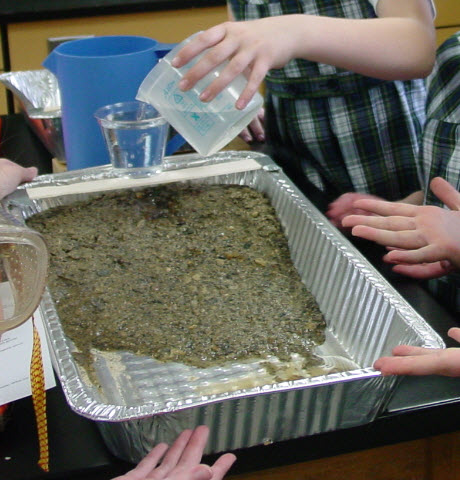

Science Standards Students who demonstrate understanding can: MS-ESS2-1 Develop a model to describe the cycling of Earth's materials and the flow of energy that drives this process. [Clarification Statement: Emphasis is on the processes of melting, crystallization, weathering, deformation, and sedimentation, which act together to form minerals and rocks through the cycling of Earth’s materials.] MS-ESS2-2. Construct an explanation based on processes have changed Earth’s surface at varying time and spatial scales. MS-ESS2-3. Analyze and interpret data on the distribution of fossils and rocks, continental shapes, and seafloor structures to provide evidence of the past plate motions. MS-ESS2-4. Develop a model to describe the cycling of water through Earth’s systems driven by energy from the sun and the force of gravity.
|
Studying erosion and deposition will lead students to the exploration of landforms and how they are formed. Stream tables using different types of sand and soil help students observe how meandering streams and braided streams through erosion lead to the creation of canyons, deltas, plateaus, mesas, and buttes. Scientific investigations illustrate the effects of erosion, deposition of soil and how our planet is constantly changing. As geomorphological, students learn how mountains are formed and how to classify the different types of valleys as U shaped or V shaped. When students review the core, mantle, and crust of the earth, they understand how these forces continue to impact the earth. Photographs and information about landforms found in the parks. Launch the lesson and view photographs and explanations about erosion, weathering, and erosion management. There are supplemental materials including a NOVA video of the Grand Canyon and animations about caves and the rock cycle. Also included are the science standards related to the lesson. The National Parks introduction to weathering and erosion worksheett. Finding resources and preparing lessons are at the top of every teacher's list. For elementary math and science teachers looking for videos or slide shows to introduce or augment a topic, check out Study Jams. These short and concise clips, featuring contemporary animated characters, present the right amount of information that students can easily digest and remember. In mathematics the core standards are covered from numbers to probability. Science topics also include the main themes of life science, physical science, and earth and space science. This video is a nice introduction to weathering and erosion. Landform Descriptions Photographs and descriptions of a variety of landforms will assist students in learning and identifying these formations. |
Lessons 1. How can you observe a mineral wear away? All you need are some rocks, chalk and a plastic jar to experiment with weathering. Pearson Publishing Handout (pdf) 2. Stream Table Prepare stream tables for your students to use for experimentation. Before Class In Class Have the students develop a hypothesis and conduct experiments using the student handout and their science journals. Stream Table Lab Handout 
|
||
|
||||
© 1996 - 2011 Linda C. Joseph
All Rights Reserved
All CyberBee Graphics are Trademarked
Graphics by
Darlene Vanasco/Creative Director
Erika Taguchi/Designer & Illustrator
Hosting Provided by Iwaynet